Effective Techniques for Tree Cutting and Removal
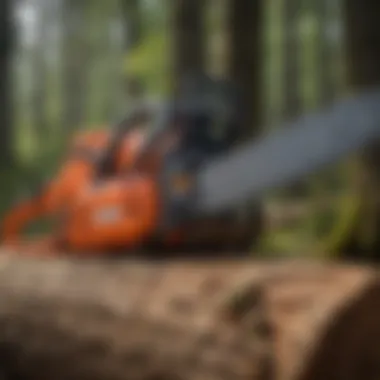
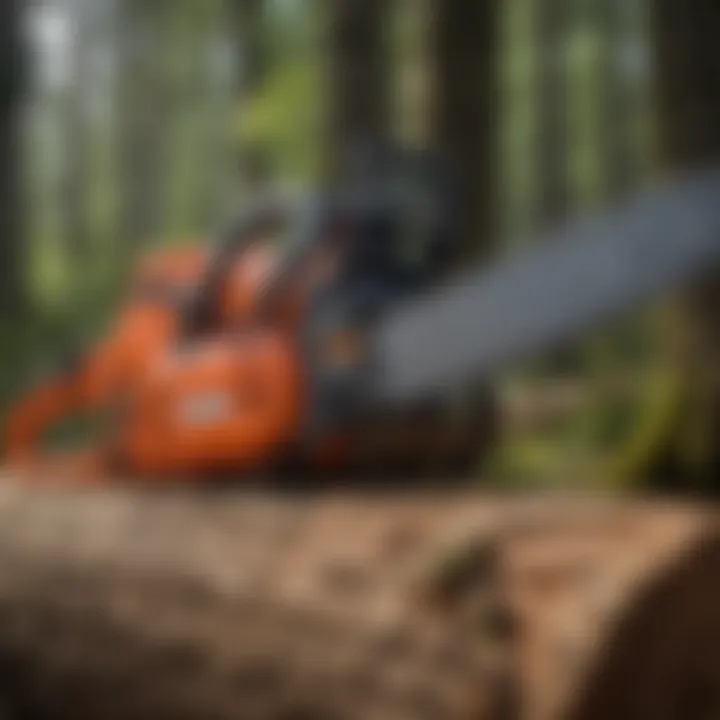
Intro
Cutting down a tree is not merely a practical task; it is an action that reverberates throughout the ecosystem. Thus, understanding the implications of tree removal is essential. This section serves as the groundwork upon which the comprehensive guide is built. We will explore the interconnectedness of trees with their environment and the responsibility that comes with their removal.
Understanding Woodland Ecosystems
To appreciate the best techniques for cutting down a tree, we must first understand the ecosystems in which these trees exist. Each tree plays a vital role, not only in providing habitat but also in maintaining the biodiversity essential for a healthy environment.
Importance of Biodiversity in Forests
Forests are home to a multitude of species. This biodiversity is critical for ecosystem resilience. When one species thrives, it supports others. For instance, oak trees provide acorns that feed various animals, while their leaves offer shelter. Loss of one species can create imbalances, affecting insects, birds, and mammals.
Role of Forests in Climate Regulation
Forests act as carbon sinks, meaning they absorb more carbon dioxide than they release. This process mitigates climate change effects, making tree preservation crucial. When removing a tree, it is vital to consider the long-term effects on carbon sequestration and local microclimates.
Sustainable Forestry Practices
To ensure that tree removal is done responsibly, understanding sustainable forestry practices is essential. These principles help in maintaining forest health, ensuring that ecosystems remain intact after a tree is cut down.
Principles of Sustainable Forestry
Sustainable forestry emphasizes the wise use of forest resources. Key principles include:
- Maintaining ecosystem health: Preventing degradation of soil and water resources.
- Minimizing waste: Utilizing as much of the tree as possible.
- Planning: Developing a management plan that takes into account the following decades.
Case Studies of Successful Implementations
Some regions have adopted sustainable practices with significant success. For example, the Forest Stewardship Council promotes certifications that ensure the management of forests to meet social, economic, and environmental needs. This practice ensures that cutting trees today doesn’t compromise future generations' ability to do the same.
Woodland Stewardship Techniques
Effective tree removal is intricately connected to broader woodland stewardship strategies. These techniques focus on managing forest resources sustainably, addressing both immediate needs and future health.
Forest Management Plans
A well-crafted forest management plan outlines the approach for each area of the forest, detailing expected outcomes and timelines. This document should include:
- Harvest schedules: Timing that minimizes disturbance and maximizes ecological benefit.
- Native species planting: Encouraging biodiversity after tree removal.
Conservation Strategies
Implementing conservation strategies protects remaining trees and the ecosystem’s integrity. Engage in:
- Buffer zones: Areas left untouched to minimize impact on water quality and habitat.
- Community involvement: Encouraging local participation ensures the sustainability plans meet the needs of those who depend on forest resources.
"A responsible approach to tree removal will consider not just the present but the future state of the woodland ecosystems."
As we advance through this guide, we will delve into the practical steps for tree cutting, emphasizing safety and ecological responsibility.
Intro to Tree Cutting
Tree cutting is a critical practice that intersects with various facets of land management, environmental stewardship, and urban development. Understanding the fundamentals of this practice forms the foundation for effective and responsible tree removal. As urban spaces expand and forests are managed, the need for informed tree cutting becomes increasingly relevant.
One of the primary considerations in tree cutting is safety. Cutting down a tree involves physical risks. It is essential for anyone involved to understand how to minimize accidents and injuries. This necessity emphasizes the importance of both personal protective equipment and proper technique.
Additionally, tree cutting has substantial ecological implications. The decision to remove a tree should factor in the health of the surrounding environment. Trees play vital roles—contributing to biodiversity, affecting soil health, and influencing local climates. Evaluating the impact of the removal of a tree helps maintain ecological balance.
Moreover, adequate knowledge of tree cutting can positively influence aesthetic values in landscapes. Whether for renovation or tree health, the removal of unfit trees creates opportunities for new growth and better tree management.
Understanding the Need for Tree Removal
Tree removal is not simply a matter of convenience; it is a critical consideration in various contexts. Trees, while often valued for their beauty and shade, can pose significant risks and challenges. This section aims to elucidate the various aspects of why tree removal may be necessary.
Health Risks of Dying Trees
Dying or diseased trees can pose serious hazards. They may become weak and unstable, resulting in the potential for branches or the entire tree to fall, thereby creating a risk to nearby structures, vehicles, and individuals. Furthermore, certain tree diseases can spread to surrounding healthy trees, exacerbating the situation. Common symptoms of a dying tree include discolored leaves, bark lesions, and significant branch dieback. Proactive removal of such trees is not only prudent but essential for maintaining a safe environment.
Impact on Surrounding Flora and Fauna
The presence of a dying or overcrowded tree can hinder the growth of other plants. Such trees may compete for vital resources like sunlight, water, and nutrients. The effects ripple through the ecosystem. For instance, removing a decaying tree can allow younger trees to flourish, improving biodiversity as more species of plants and animals can thrive. Additionally, when trees die, they may attract pests and pathogens that can disrupt the local ecosystem. Hence, understanding these dynamics is crucial when assessing tree health and removal.
Aesthetic and Space Considerations
Aesthetic implications can be significant when considering tree removal. A tree may obstruct a desirable view or limit natural light into a space. In landscaped areas, the removal of non-flourishing trees can enhance the overall beauty and usability of the environment. Furthermore, when a tree is removed, it may create new opportunities for planting that align with the desired landscape design. This decision requires careful thought to ensure that it contributes positively to the overall aesthetic while considering future growth and development.
In summary, understanding the need for tree removal is essential for ensuring safety, encouraging ecological balance, and enhancing aesthetic appeal in any given environment.
Determining the necessity of tree removal involves a comprehensive evaluation of the health of the tree, its ecological relationships, and its impact on the surrounding area. Assessing these factors is vital for informed decision-making regarding tree management.
Safety Precautions Before Cutting
When it comes to cutting down a tree, safety precautions are crucial. Trees can pose significant risks to both the person wielding the tools and those nearby. By following safety guidelines, you can mitigate these risks and ensure a safer cutting process. Understanding the environment, wearing proper protection, and identifying potential hazards can help prevent accidents.
Personal Protective Equipment (PPE)
Personal Protective Equipment, or PPE, is essential for anyone involved in tree cutting. The term encapsulates various types of gear designed to protect against injury. Key items include:
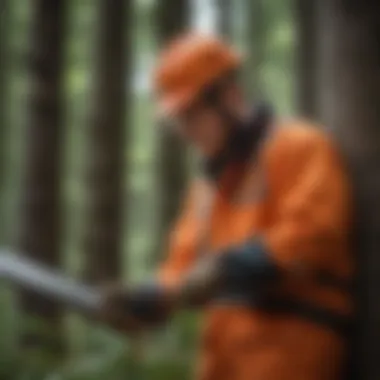
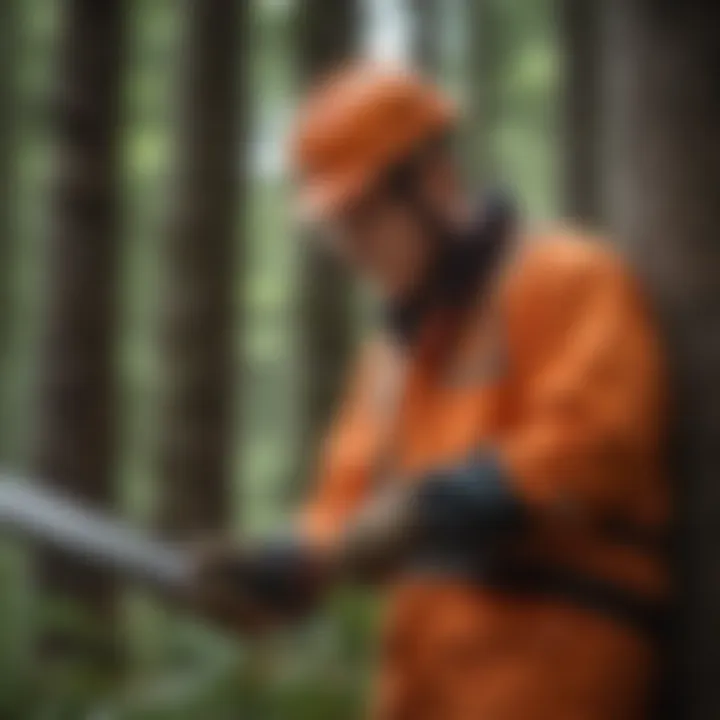
- Hard Hats: These protect the head from falling branches.
- Chainsaw Chaps: These are worn on legs to prevent cuts from chainsaws.
- Safety Glasses: Protects eyes from sawdust and debris.
- Ear Protection: Helps reduce noise induced hearing loss from power tools.
- Gloves: Offers grip and protects hands from cuts and abrasions.
Proper use of PPE not only safeguards the individual but also builds a culture of safety within the workplace or community.
Assessing the Environment
Before starting the cutting process, it's vital to assess the environment around the tree. Conditions affecting the cutting process can include:
- Proximity to Structures: Identify buildings, fences, or roads that may be impacted by the falling tree.
- Terrain Stability: Understand ground conditions, as a steep incline or loose soil can affect balance and footing.
- Weather Conditions: Wind can significantly influence tree movement and direction when cutting, increasing the risk of accidents.
This assessment helps in making informed decisions about cutting techniques and safety measures required before commencing work.
Identifying Hazards
Every cutting scenario has unique hazards that must be identified prior to any actions. Some common hazards include:
- Overhead Obstacles: Look for nearby power lines or branches that may interfere with the tree's fall.
- Electrical Hazards: Ensure there's no risk of power line contact during the felling process.
- Wildlife: Be cautious of animals that may be nesting within the tree or nearby surroundings.
Documenting these hazards enables proper planning and preparation, reducing the chance of accidents occurring during the cutting process.
Safety first: In tree cutting, a robust approach to safety governs successful operations and promotes well-being.
Tools Required for Tree Cutting
The process of tree cutting relies heavily on the right tools. Selecting proper instruments can greatly enhance efficiency and safety during tree removal. Each type of tool has its distinct functions, benefits, and limitations. Understanding these helps in achieving the desired results while minimizing risks. In the following sections, we will examine various hand tools, power tools, and safety gear that are essential for effective tree cutting.
Hand Tools
Hand tools are fundamental for tree cutting tasks, especially for underbrush and small to medium-sized trees. They provide precision and control, allowing the user to work effectively in tight spaces or delicate environments.
Saws
Saws are critical hand tools for cutting trees. Their primary characteristic is their sharp teeth, designed for slicing through wood effectively. Saws come in various sizes and types, making them versatile for different tasks. A key benefit of using saws lies in their demand for less power, making them accessible for those who may not have extensive experience. However, the primary drawback is the manual effort required, which can be physically demanding. Choices include hand saws for straightforward cuts and bow saws for tougher branches.
Axes
Axes hold a significant role in tree removal as well. They are strong, with a heavy blade that can displace large amounts of wood quickly. The key characteristic of axes is their ability to deliver powerful strikes, making them effective for felling trees and splitting wood. Axes are popular because they do not rely on fuel or electricity, making them reliable in remote areas. However, using an axe can be exhausting and requires skill to prevent injury while aiming for accuracy, which can be a disadvantage in less experienced hands.
Pruning Shears
Pruning shears are suitable for smaller branches and detailed work. These tools are categorized by their sharp, scissor-like blades. They are essential for maintaining healthy trees and shrubs, thus contributing to effective tree management. Pruning shears are beneficial for their ease of use and portability, allowing for effortless handling. The downside is that they are not suitable for cutting larger branches, limiting their usage.
Power Tools
Power tools represent a leap in efficiency and can significantly reduce manual labor during tree cutting. They are more suited for larger trees or more extensive cutting tasks due to their power.
Chainsaws
Chainsaws are arguably the most popular power tool for tree cutting. They have a rotating chain that cuts rapidly through wood, allowing for quick and effective tree removal. Their primary characteristic is the speed with which they can fell trees or cut wood into manageable pieces. Chainsaws are favored for their power, which makes them ideal for extensive and thick branches. However, they demand proper training to operate safely and maintain, as they can pose risks if misused or handled carelessly.
Pole Saws
Pole saws are designed for reaching high branches without needing a ladder. The tool features a saw mounted on a pole, providing additional reach. Its significant benefit is that it minimizes risks associated with climbing. Pole saws are a strong choice for those needing to trim trees or shrubs at height. Conversely, they may have limitations in cutting thicker branches, depending on the motor's power.
Safety Gear and Accessories
Proper safety gear is non-negotiable in tree cutting. These accessories protect the individual performing the task, ensuring that safety remains a priority throughout the process.
Helmets
Safety helmets are vital for protecting the head from falling branches or tools. These are designed with impact-resistant materials, making them essential for tree cutting. A key feature is their ability to absorb shocks, reducing the risk of injury during the cutting process. While helmets are a crucial part of safety gear, they can be uncomfortable in hot weather, leading to less convenience.
Gloves
Gloves provide necessary protection for the hands while working with sharp tools and rough materials. They are typically made from tough materials that protect against cuts and abrasions. A primary advantage of gloves is their ability to enhance grip, reducing the chances of accidents. However, users must choose gloves that allow for both protection and dexterity, as overly thick gloves can limit hand movement.
Chaps
Chaps are protective coverings worn over the legs. They are designed to safeguard against chainsaw injuries, consisting of layered materials that can stop the chain upon contact. The most significant benefit of chaps is the added protection they provide to a vital part of the body. On the downside, they may be cumbersome during prolonged use, leading some to forgo proper safety gear.
"Using the right tools is crucial not just for efficiency, but for ensuring safety during the tree cutting process."
Cutting Techniques
Understanding effective cutting techniques is crucial for anyone involved in tree removal. The method chosen impacts not only the safety of the operation but also the fate of surrounding environment. Proper cutting techniques can help ensure that the tree falls in the desired direction, minimizing damage to nearby structures or other trees. Additionally, different cutting methods are suited for various tree sizes and conditions, making it essential to evaluate each situation carefully.
Notch Cutting Method
The notch cutting method is a fundamental technique in tree felling. This method involves creating a notch on the side of the tree that faces the direction in which the tree is intended to fall. The notch serves as a guide and allows for better control over the tree's direction when it begins to fall.
Key characteristics of this method include:
- Control: By placing the notch correctly, the cutter can influence the tree's trajectory.
- Safety: It allows the cutter to work from a safer distance when the tree falls.
However, one must consider the depth and angle of the notch. A poorly executed notch can lead to erratic movements of the tree, increasing risk.
Felling Techniques
Felling techniques include several methods, but two of the most prominent are the back cut and the wedge cut. Each of these methods plays a significant role in safely bringing the tree down.


Back Cut
The back cut is the second cut made after the notch is created. It usually occurs on the opposite side of the tree from the notch. This cut removes the tree's remaining support and allows it to fall.
A key characteristic of the back cut is its ability to create a hinge that controls the tree's fall. The hinge's thickness is critical as it affects control over the direction and the speed at which the tree falls. This technique is a popular choice due to its effectiveness in managing larger trees.
However, if the back cut is too deep, it can lead to a situation known as "barber chairing," where the tree can split unpredictably.
Wedge Cut
The wedge cut is another effective felling technique that involves removing a wedge-shaped portion from the tree trunk. This cut can be made either before or after the notch is created. The wedge cut creates a channel that ensures the tree falls in the desired direction.
A key characteristic of this method is its ability to direct the fall more precisely. It can be especially beneficial in situations where the tree leans or is surrounded by obstacles.
Nonetheless, the wedge cut requires careful planning since it influences the structural integrity of the tree during the cutting process. If not executed correctly, it can lead to significant risks.
Sectional Felling
Sectional felling is a method utilized primarily in confined spaces or when cutting down large trees. This technique involves taking the tree down in sections, allowing for great control over the branches and trunk. It can significantly reduce the potential for damage to surrounding areas and enhances safety.
The cutter may use a combination of techniques, including rope rigging, to lower sections safely. This method is particularly useful when dealing with trees near buildings or other sensitive areas.
Factors Influencing Tree Direction
Understanding the factors that influence tree direction is a fundamental aspect of safe tree cutting. These factors determine how a tree will fall during the cutting process. A miscalculation can lead to dangerous situations, including damage to property or, worse, risk to human safety. Knowledge of these elements aids in ensuring controlled and intended felling of the tree. Here, we will explore three critical aspects: tree lean and weight distribution, wind conditions, and surrounding structures and obstacles.
Tree Lean and Weight Distribution
The natural lean of a tree significantly affects the direction in which it will fall. Trees often grow leaning towards sunlight, which might create an imbalance. Assessing the tree’s angle and where the majority of its weight lies will guide you in predicting its fall path. In general, the tree will tend to fall in the direction of its lean.
When cutting down a leaning tree, it is vital to assess the weight distribution. A tree with uneven weight may respond unexpectedly when cut, leading to uncontrolled descents. Factors such as the tree's height and thickness also come into play. Always take the time to examine these characteristics before initiating any cutting.
Wind Conditions
Wind conditions can significantly affect the behavior of a falling tree. A strong wind will not only push the tree, causing it to fall in an unintended direction, but it can also create additional hazards, such as falling branches or debris.
It is prudent to check the wind speed and direction before cutting. A gentle breeze might not present a threat, but gusty winds can shift rapidly, altering your original plans. If wind conditions are unfavorable, it may be wise to postpone cutting until conditions improve.
Surrounding Structures and Obstacles
The presence of nearby structures and obstacles is a key consideration in tree cutting. These include buildings, power lines, fences, and other trees. The fall direction must clear all potential hazards to minimize risks.
When assessing the area, imagine a clear fall zone around the tree. This zone should be free from any encumbrances that could cause damage or injury. It is often helpful to mark this area clearly, ensuring all individuals involved understand the safety protocols before commencing the cutting.
Post-Cutting Considerations
After successfully cutting down a tree, the focus shifts to the considerations that arise post-cutting. This phase is crucial as it affects both the immediate surroundings and the long-term ecological impact. Understanding and addressing post-cutting considerations can lead to effective land management, pest control, and overall environmental health.
The key elements often regarded in this stage include stump removal options, wood utilization and management, and erosion prevention measures. Each of these aspects plays a pivotal role in ensuring sustainable practices in tree management. Failure to properly address them could lead to ecological imbalance or undesirable land conditions.
Stump Removal Options
When a tree is cut down, what remains is often the stump. The decision on how to manage this leftover part is important. Common methods include digging and grinding, each with its characteristics and outcomes.
Digging
Digging out the stump involves removing it physically from the ground, which can be labor-intensive. This method is notable for being a natural approach as it removes the entire root system, which helps prevent regrowth. This option is popular among those who prefer to maintain the soil’s natural composition without introducing machinery.
However, digging can be time-consuming and may require heavy equipment, particularly for larger trees. Additionally, the excavation process can disturb surrounding soil and vegetation, potentially causing temporary ecological disruption.
Grinding
Grinding, on the other hand, uses a stump grinder to break down the stump and roots into wood chips. This method is efficient and less labor-intensive compared to digging. The use of machinery speeds up the process and minimizes soil disturbance.
The unique feature of grinding is that it allows for leaving the root system relatively intact underground, which may benefit soil health. However, it may not remove all roots, leading to possible future sprouting. Furthermore, the shredded material can become cumbersome if not managed correctly.
Wood Utilization and Management
Once the tree is down, the value of the wood can be leveraged. There are several ways to utilize the wood effectively. Firewood and mulch are common alternatives to simply disposing of the wood material.
Firewood
Firewood is a popular option for utilizing cut trees. It offers a sustainable heating source. The key characteristic of firewood is its convenience for homeowners, providing a way to repurpose the tree into usable energy.
Collecting and seasoning the wood for future use can be a beneficial process, but it requires time and knowledge of proper storage methods. Not all wood is suitable for burning, and certain species may produce more smoke or pollution than others.
Mulch
Another great way to use the wood from a cut tree is to turn it into mulch. Mulch serves various gardening purposes, such as soil moisture retention and weed prevention. Its key characteristics make it an excellent choice for landscaping and garden health.
However, fresh mulch may attract pests or contribute to disease if not managed correctly. Using aged mulch can mitigate these risks. Still, it is crucial to ensure that the mulch does not encircle tree trunks or dry out the soil excessively.
Erosion Prevention Measures
Finally, after tree removal, checking for erosion is vital. Tree roots play a significant role in holding soil in place. Their removal can lead to soil erosion, especially on slopes or near bodies of water. Implementing erosion prevention measures helps maintain soil integrity and reduces runoff.
These measures can include:
- Planting ground cover: By increasing ground vegetation, soil is naturally stabilized.
- Installing barriers: Such as rocks or logs to slow down water flow and reduce soil loss.
- Outsourcing to professionals: They can provide tailored solutions for specific landscapes and conditions.
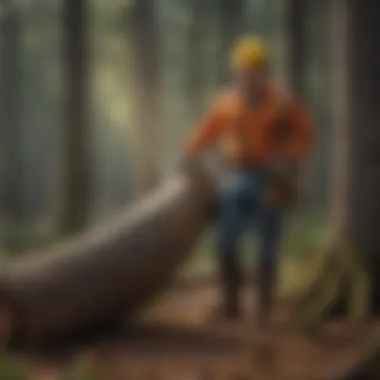
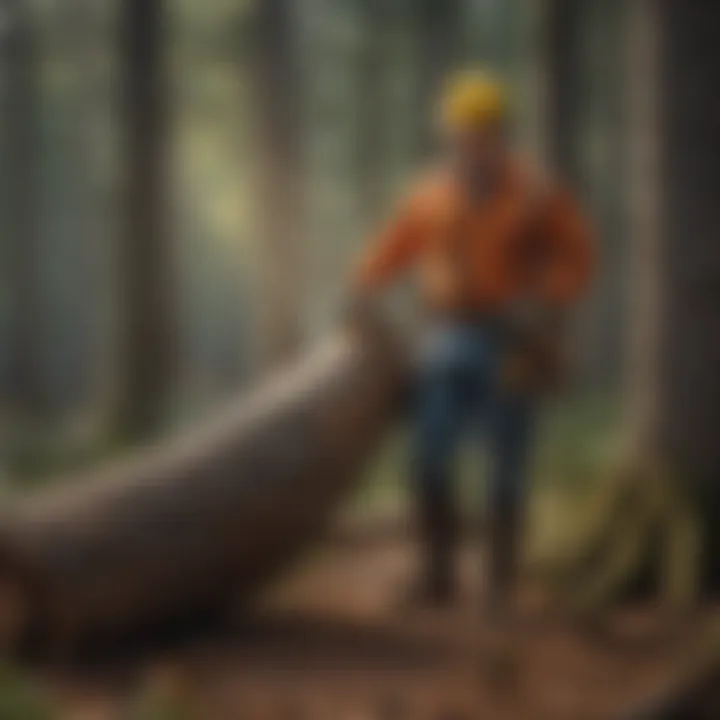
Assessing the land post-cutting allows for timely intervention and can prevent more significant environmental issues down the line.
Failure to consider these post-cutting measures can lead to more complex problems in the future, impacting both ecology and land usability.
In summary, each of these post-cutting aspects is vital for ensuring that tree removal aligns with best practices for land stewardship and sustainability.
Ecological Implications of Tree Cutting
Cutting down trees is not merely a practical endeavor; it carries weighty ecological implications. Understanding these effects is crucial for forestry professionals and anyone involved in land management. Trees serve as vital components of the ecosystem, influencing biodiversity, offering habitat for wildlife, and impacting soil health. It is essential to consider these factors before proceeding with tree removal to ensure a balanced approach to tree management.
Biodiversity Considerations
The act of cutting down trees directly influences biodiversity. Trees provide essential habitats for a wide range of species, from birds to insects to mammals. When a tree is removed, its associated flora and fauna often suffer. Loss of canopy can lead to increased sunlight reaching the forest floor, which alters the growth of underbrush and may favor invasive species over native ones. If tree removal is unavoidable, it is prudent to look for ways to sustain or replace the habitat, ensuring biodiversity resilience.
- Native Species Protection: Special attention should be given to trees hosting rare or endangered species.
- Regenerative Practices: Post-cutting replanting can help maintain biodiversity by introducing a diverse mix of native species.
- Monitoring Biodiversity Impact: Conduct assessments before and after cutting to evaluate changes in species populations.
Wildlife Habitat Disruption
The removal of trees can disrupt local wildlife habitats significantly. Many animals rely on trees for shelter, food, and nesting. Birds, for example, depend on live trees for nesting sites and foraging opportunities. When trees are gone, wildlife must adapt to loss of habitat, which can lead to decreased populations or even local extinctions.
While tree cutting may offer short-term benefits, the long-term effects on wildlife should never be underestimated.
- Species Migration: Animals may be forced to migrate, causing higher competition for resources in their new environments.
- Ecosystem Imbalance: The loss of one species may lead to overpopulation of another, creating more complex ecological issues.
Soil Health and Fertility
Trees contribute significantly to soil health. Their roots help anchor the soil, preventing erosion. Moreover, fallen leaves and organic matter decompose and enrich the soil with nutrients. Cutting down trees can lead to soil degradation.
- Erosion Risks: Without tree roots to hold the soil, the likelihood of erosion increases, damaging the land’s usability.
- Nutrient Depletion: The removal of organic matter decreases the nutrient profile of the soil, making it less fertile for new plant growth.
- Increased run-off: Tree canopies help slow rainfall. Without them, excess run-off can lead to flooding and disrupt the natural flow of water.
Before commencing with tree cutting, it is vital to assess the ecological implications thoroughly. Each action has consequences that reach beyond the immediate area, affecting the health of broader ecosystems. Awareness and foresight lead to more sustainable practices.
Legal Considerations and Regulations
Understanding the legal considerations and regulations surrounding tree removal is critical. Engaging in tree cutting without proper knowledge can lead to significant legal ramifications. Familiarity with local laws helps prevent potential fines or legal disputes while ensuring responsible practices. For both amateur and professional tree cutters, recognizing these guidelines provides clarity and structure in their operations.
Local and State Laws
Local and state laws vary widely, which makes it imperative to know what rules govern your area. Often, municipal regulations dictate which trees can be cut down, especially in urban settings. Certain species might be protected due to their ecological importance or heritage status. Additionally, the tree’s location in proximity to other properties can also affect the legalities surrounding its removal. Therefore, before beginning any cutting activity, it's advisable to consult local ordinances.
- Protected Species: Some species are protected by law.
- Urban Tree Regs: Cities often have stricter rules than rural areas.
- Community Restrictions: Some neighborhoods may have their agreements.
Permits and Licenses Required
In many cases, removing a tree necessitates obtaining a permit. This requirement is particularly common for larger trees or those in designated conservation areas. The permitting process often involves a review of the reasons for cutting the tree, its health status, and the potential impact on the surrounding environment. An application may ask for the following details:
- Exact location of the tree.
- The size and species of the tree.
- Reason for removal.
Failure to secure appropriate permits can result in penalties that may include fines and requirements to replace the tree. It is important to comply with these regulations to maintain community standards and ecological sustainability.
Environmental Protection Regulations
Various environmental protection regulations aim to ensure that tree cutting does not adversely affect biodiversity and ecosystem health. These regulations may require assessments of potential impacts on wildlife habitats, soil deterioration, and water quality. Tree removal in sensitive habitats or during specific seasons may be limited to prevent harm to local wildlife, particularly during breeding periods.
Important: It is always best practice to assess potential environmental impacts before removing any tree.
Engaging in practices that align with environmental regulations helps in sustaining biodiversity. Ignoring these guidelines not only impacts the environment negatively but may also expose individuals to legal actions.
In summary, adhering to local and state laws, securing necessary permits, and complying with environmental regulations are essential components of responsible tree cutting. By following these guidelines, both individuals and professionals can contribute to sustainable practices in forestry.
Engaging Professional Services
When it comes to tree cutting, engaging professional services can significantly enhance both safety and efficacy. Attempting to remove a tree without the proper skills or equipment can lead to serious accidents or damage to surrounding property. Conversely, professional tree cutting services provide trained experts who understand the intricacies of tree biology and removal techniques. This section explains when to hire professionals, how to choose the right service, and what qualifications to look for.
When to Hire a Professional
Recognizing when to hire a professional can determine the success of your tree removal project. Here are some situations that warrant professional assistance:
- Size of the Tree: Large trees, particularly those over 20 feet tall, present inherent risks. Their weight and height make them difficult to manage safely without proper equipment.
- Location: Trees situated close to structures, power lines, or other obstacles require expert handling. The risk of collateral damage is higher, making professional expertise essential.
- Health and Stability: If a tree shows signs of decay or instability, it can fall unexpectedly. Professionals can assess the situation better and take calculated measures to ensure safety.
Choosing a Tree Cutting Service
Selecting a reliable tree cutting service involves several careful considerations. Look for:
- Licensing and Insurance: Ensure the service is licensed to operate in your area. Insurance is also critical. It protects you from liability in case of accidents.
- Reputation: Research customer reviews and ask for recommendations. A good reputation often indicates reliable service and quality work.
- Services Offered: Some companies specialize in tree removal only, while others may offer additional services like stump grinding or tree health assessments. Ensure their offerings align with your needs.
Evaluating Professional Qualifications
Not every tree cutting service is created equal. Evaluating qualifications can save you from potential issues. Here are key factors to consider:
- Certifications: Look for certifications from recognized organizations such as the International Society of Arboriculture. These signify knowledge and training in tree care and safety practices.
- Experience: Inquire about their years in the industry. A seasoned team is likely to handle unexpected challenges more efficiently.
- Safety Practices: Ask about their safety protocols. Professionals should prioritize safety measures like personal protective equipment and safe cutting techniques.
Engaging professionals minimizes risks and ensures an efficient tree removal process.
Epilogue
The conclusion serves as a vital component of this article, encapsulating the main points discussed throughout the various sections. Addressing the complexities of tree removal goes beyond simple cutting techniques. It requires an understanding of safety measures, legal regulations, ecological impacts, and potential consequences for the surrounding environment.
The information provided aims to highlight various considerations essential for safe tree cutting. For instance, understanding the specific tools and techniques needed is crucial for effectiveness and safety. A thorough grasp of local regulations can prevent legal ramifications and ensure compliance with environmental protection standards. Furthermore, recognizing the ecological implications promotes responsible management practices.
In summary, effective tree cutting is a multifaceted task that demands attention to detail. It involves not only the physical act of cutting but also a commitment to safety, legality, and ecology.
"A responsible approach to tree management ensures that both human needs and ecological health are maintained."
By synthesizing the contents discussed, the reader can appreciate the depth of knowledge required to engage in tree clearing operations responsibly. This article serves as a comprehensive guide for both novices and professionals in forestry, emphasizing that informed practices lead to sustainable outcomes.







